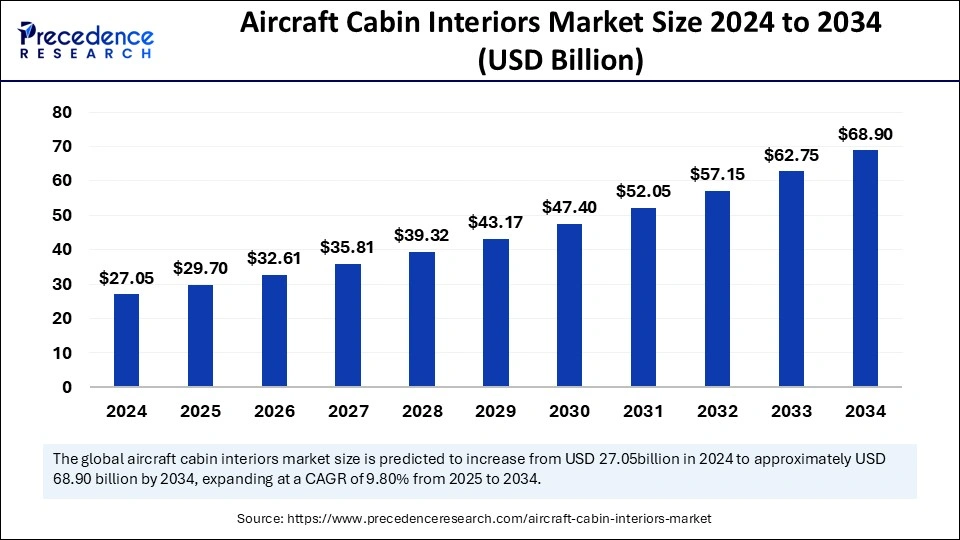
Aircraft Cabin Interiors Market Key Takeaways
- North America dominated the aircraft cabin interiors market with the largest share of 44% in 2024.
- Asia Pacific is expected to grow at the fastest CAGR during the forecast period.
- By type, the in-flight entertainment & connectivity segment held the dominant share of the market in 2024.
- By type, the aircraft galleys segment is expected to grow at the fastest rate between 2025 and 2034.
- By platform, the narrow-body aircraft segment led the market in 2024.
- By platform, the wide-body aircraft segment is anticipated to grow at the highest CAGR over the studied years.
- By material, the alloys segment dominated the global market in 2024.
- By material, the composites segment is projected to expand rapidly in the coming years.
- By end-user, the aftermarket segment dominated the market in 2024.
- By end-user, the OEM segment is expected to grow at the fastest rate during the projection period.
Market Overview
The aircraft cabin interiors market in commercial aviation has been experiencing a steady transformation driven by evolving passenger expectations, technological innovation, and competitive differentiation among airlines. Airlines are prioritizing comfort, functionality, and aesthetics in cabin design to improve customer satisfaction and loyalty. The market encompasses seating, lighting, in-flight entertainment systems, galley equipment, lavatories, and storage compartments. As global air travel continues to recover from pandemic-era declines, demand for upgraded cabin interiors has surged, especially in narrow-body and long-haul fleets.
Drivers
Key drivers include the resurgence in air passenger traffic, especially in emerging markets, and the growing focus on enhancing passenger experience. Airlines are investing in cabin modernization as a competitive tool, offering enhanced entertainment systems, mood lighting, and more spacious seating. Technological advancements, such as wireless connectivity and lightweight composite materials, are also fueling interior upgrades. Additionally, aircraft retrofitting programs are becoming more common as carriers aim to extend fleet lifespan while aligning with modern standards.
Opportunities
There is substantial opportunity in designing modular and customizable interiors that cater to different passenger demographics and regional preferences. The adoption of smart cabin technologies, such as IoT-enabled systems and AI-based lighting or temperature control, offers exciting avenues for innovation. Another opportunity lies in the low-cost carrier (LCC) segment, which is increasingly adopting more comfortable and cost-effective interiors to boost customer appeal without sacrificing operational efficiency.
Challenges
The market faces several challenges, including strict regulatory requirements related to safety, certification, and material flammability. High costs and long lead times associated with cabin retrofitting can deter some airlines. Supply chain disruptions and labor shortages in aircraft manufacturing and maintenance further complicate production timelines. Moreover, balancing cost-efficiency with luxury remains a complex challenge, especially in the economy class segment.
Regional Insights
North America leads the market due to the presence of major airline fleets and cabin interior manufacturers. Europe follows closely with a strong emphasis on passenger comfort and premium travel experiences, particularly in long-haul flights. Asia-Pacific is witnessing the fastest growth, driven by expanding middle-class air travel and rising domestic aviation markets in countries like India and China. The Middle East remains a strong player in premium cabin innovations, especially among flagship carriers.
Recent Developments
Recent years have seen the launch of next-generation seating configurations, including staggered business class layouts and fold-flat economy pods. Airlines are also introducing eco-friendly and antibacterial materials for cabin components. Major OEMs and suppliers have formed partnerships to develop energy-efficient lighting systems and modular galley units. Touchless in-cabin technologies and advanced air filtration systems are becoming standard, driven by post-pandemic health concerns.
Aircraft Cabin Interiors Market Companies
- The Boeing Company
- Thales Group
- Panasonic Corporation
- JCB Aero
- Hong Kong Aircraft Engineering Company Limited
- Honeywell International Inc.
- Gogo, Inc
- Collins Aerospace
- Cobham PLC
- Astronics Corporation
Segments Covered in the Report:
By Type
- In-flight Entertainment & Connectivity
- Aircraft Seating
- Aircraft Galleys
- Aircraft Cabin Lighting
- Aircraft Lavatories
- Aircraft Windows & Windshields
- Aircraft Storage Bins
- Aircraft Interior Panels
By Platform
- Narrow-body Aircraft
- Regional Transport Aircraft
- Wide-body Aircraft
- Business Jet
By Material
- Composites
- alloys
- Others
By End-user
- MRO
- Aftermarket
- OEM
By Region
- North America
- Europe
- Asia Pacific
- Latin America
- Middle East and Africa